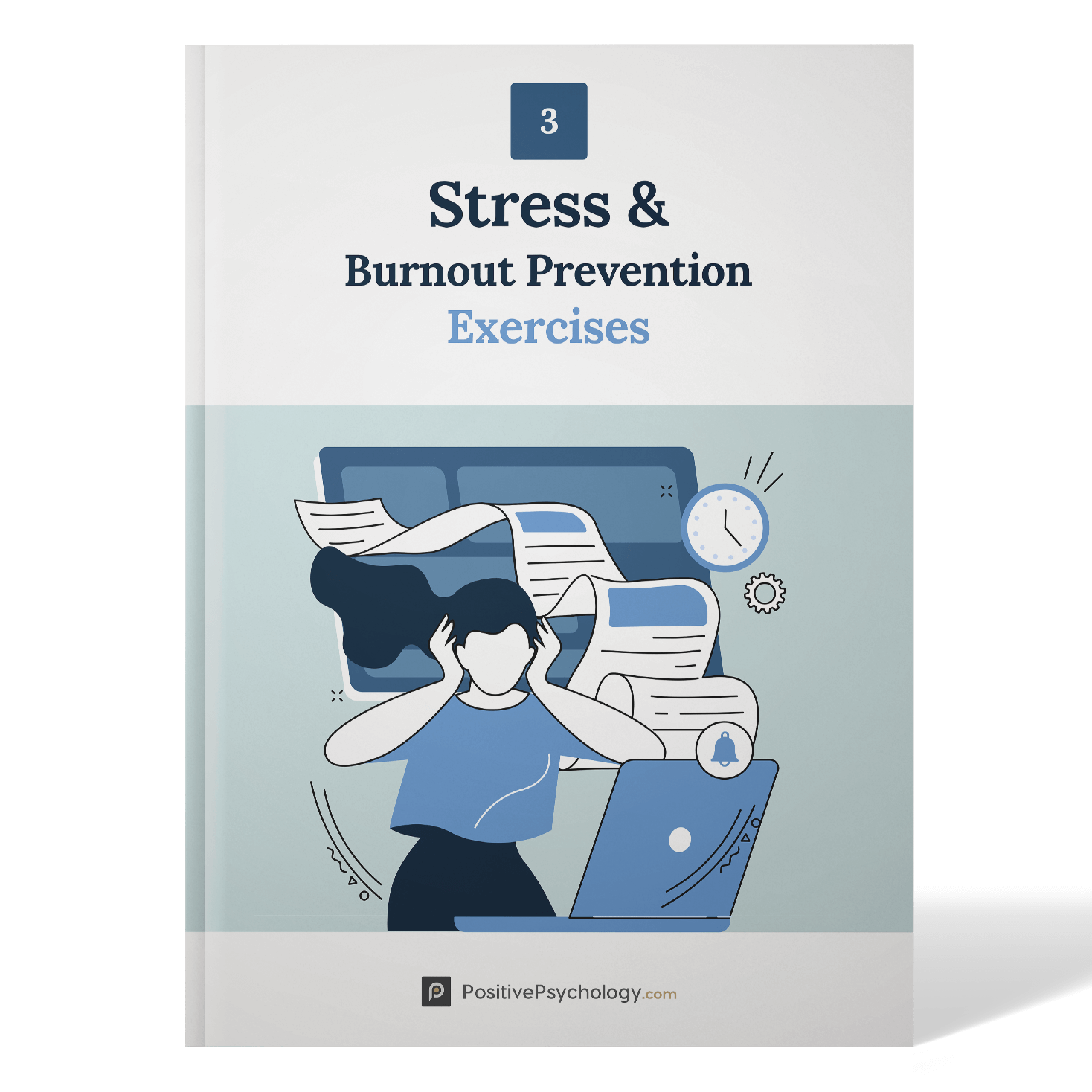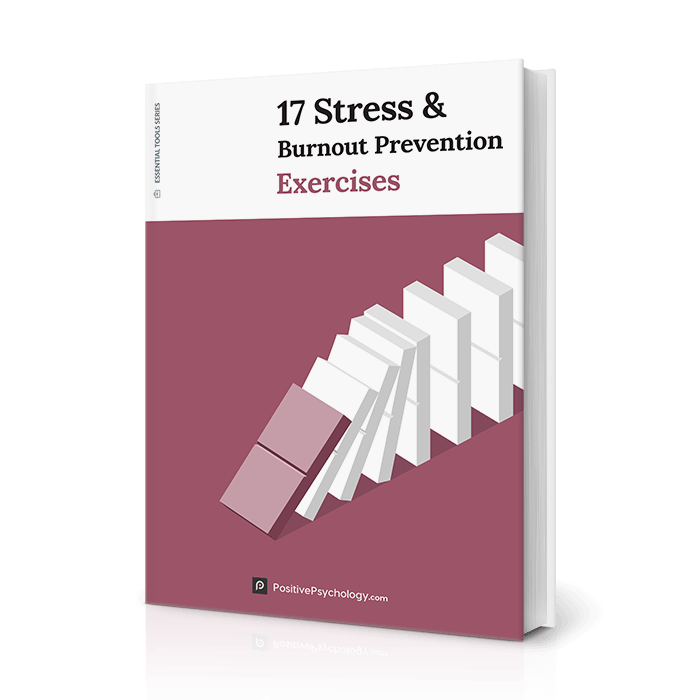10 Techniques to Manage Stress & 13 Quick Tips
 We have all felt stress and its effects. After all, the experience of feeling threatened and unable to manage stress can significantly impact how we think, feel, and behave.
We have all felt stress and its effects. After all, the experience of feeling threatened and unable to manage stress can significantly impact how we think, feel, and behave.
Short-term, manageable stress levels can help us grow our resilience to future challenges and motivate and energize us to act. And yet, chronic, ongoing stress can harm us physically and mentally, impacting our relationships with ourselves and those around us (Boniwell & Tunariu, 2019).
This article explores stress, its impact, and the risk of burnout. We then explore techniques, exercises, and tips to help us reduce its harmful effects and reframe how we see pressure while regaining our sense of control.
Before you continue, we thought you might like to download our three Stress & Burnout Prevention Exercises (PDF) for free. These science-based exercises will equip you and those you work with, with tools to manage stress better and find a healthier balance in your life.
This Article Contains:
- Understanding Stress Levels
- What is Stress and What is Burnout?
- How To Reduce Psychological Stress
- 7 Effective Stress Management Techniques
- 13 Skills & Tips to Manage Stress Better
- 3 Further Stress Relief Activities
- Stress Management Worksheets from PositivePsychology.com
- A Take-Home Message
- References
Understanding Stress Levels
While stress in small, infrequent doses may not be harmful, “prolonged stressful living can cause havoc on our physical, emotional, and psychological wellbeing” (Boniwell & Tunariu, 2019, p. 132).
Indeed, some day-to-day stress is normal, but it is essential to spot when stress levels are too high, too often. Better awareness can be helpful, including watching out for the following physical indicators (WebMD, 2020):
- Tense or painful muscles
Possibly experienced in the shoulders, back, chest, stomach, or head. - Digestive issues
Including nausea, vomiting, diarrhea, and constipation. - Sexual health and wellbeing
Lowered sex drive, impotence in men, and irregular periods in women. - Heart and blood pressure
Increased release of stress hormones (cortisol and adrenaline) putting us in fight-or-flight mode can impact heart rate and blood pressure.
Each physical indicator can become part of our self-awareness and may suggest when stress is getting out of hand.
Some stress counselors use biofeedback technology to assess stress levels, potentially using (modified from Blackett, n.d.):
- Resting heart rate
Heart rate taken at rest is often used to indicate overall fitness, but can suggest a change in stress levels. - Heart Rate Variability (HRV)
HRV is the shift in time between heartbeats. Changes in pattern may indicate the impact of stress levels on our underlying autonomic nervous system. - EEG or brainwaves
Electroencephalograms (EEG) record brain activity. Specific markers can indicate stress. - Breathing assessment
Feeling stressed can be associated with overbreathing (breathing more than is needed to meet the body’s needs) or faster, chest-based breathing. - Adrenal assessment
Blood and urine samples can be taken to measure stress hormone levels, such as cortisol and adrenaline. - Skin conductance and skin temperature
Changes to the sympathetic nervous system can be measured in the skin. - Sleep tracking
Quality and quantity of sleep are often impacted by increased stress and are easily monitored through trackers.
Whatever form self-monitoring takes, noticing the early warning signs of burnout and stress can prove helpful in managing our self-care and wellbeing (Bush, 2015).
What is Stress and What is Burnout?

And yet, while such ‘stress inoculation’ is associated with resilience, in excess or too frequent, stress can be damaging to both mind and body (Boniwell & Tunariu, 2019).
Indeed, whether a single event or ongoing, stress can result in several ‘thinking traps,’ including (Boniwell & Tunariu, 2019):
- Jumping to conclusions
These are often unhelpful or unfounded. - Tunnel vision
Limiting our ability to problem solve and move forward. - Catastrophizing
Maximizing the negatives and minimizing the positives. - Casting blame
External or internal assignment of blame. - Overgeneralizing
Minor setbacks specific to one event are applied more widely. - Unhelpful emotional reasoning
We may become more upset than the situation suggests or demands, leaving us anxious and overwhelmed.
Research shows that work can be an extreme source of stress, particularly in high-pressure environments such as healthcare. A 2016 study exploring stress and coping in oncology, suggested that stress levels could be reduced in response to more support from management and better staffing levels (Ko & Kiser-Larson, 2016).
Preventing burnout within the workplace has received much more attention in recent years. And while a unified definition has proven challenging, in 2019, the World Health Organization categorized it as an occupational phenomenon that results from unsuccessfully managed chronic workplace stress (HBR guide to beating burnout, 2021).
Most importantly, they recognized the organization’s role in causing it and their subsequent duty to protect their employees (HBR guide to beating burnout, 2021).
How To Reduce Psychological Stress
While resilience is often described as the ability to bounce back from difficult times, research suggests there may be more to it than that. Successfully coping with stress typically involves one, or a combination, of the following (Boniwell & Tunariu, 2019):
- Recovery
Our ability to return to and restore normal life at pre-stressor levels of functioning. - Resistance
When we show little or no impact in response to a stressor or stressful event. - Reconfiguration
A return to a new normal. A significant event may change who we are and how we live – positively or negatively.
Unlike recovery and resistance, reconfiguration suggests transformation; rather than returning to pre-stressor function, we travel beyond maintaining or sustaining our old lives.
Accepting a ‘new normal’ can help us reduce psychological stress and move forward.
Attempts to understand why we differ in our response to stress suggest that our sense of coherence (SOC) may also be important in lowering our suffering and experience of difficult emotions (Boniwell & Tunariu, 2019).
Indeed, research suggests that the “extent to which one is confident that internal and external environments are predictable and that there is a high probability that life situations will work out as well as can be expected” is influenced by our (Boniwell & Tunariu, 2019, p. 137):
- Comprehensibility
Our degree of insight into our achievements and difficulties and our awareness of our resources. - Manageability
Our belief that things will work out as we expect and that our resources are adequate and appropriate. - Meaningfulness
Our motivation surrounding our wish to cope and move on.
Additionally, according to Martin Seligman, hope and optimism about future outcomes are vital factors in our overall wellbeing and ability to overcome life’s difficulties. They belong to a “family of strengths that represent a positive stance toward the future.” (Seligman, 2011, p. 260).
7 Effective Stress Management Techniques

Recognizing how we currently deal with stress and anxiety
Stress and anxiety are a part of life. The difference between those that handle such unpleasant feelings well and those that don’t may depend on how they make sense of them (Forsyth & Eifert, 2016).
Understanding how we react and behave when confronted by stressful situations and anxiety can help us recognize how to better manage stress going forward.
Existing stress responses
Ask your client to consider which of the following applies to them (Forsyth & Eifert, 2016):
- Do you run away from or avoid stressful and anxiety-inducing situations?
- Do you suppress or push out feelings that are upsetting?
- Do you distract yourself from stress (keeping busy, eating, drinking alcohol)?
- Do you replace ‘bad’ thoughts with ‘good’ thoughts?
- Do you talk yourself out of feeling anxious, stressed, or worried?
- Do you seek help (therapy, stress-relief books, chatting with friends)?
This list is not exhaustive or judgmental. It is simply a list of some responses–positive and negative–people have to stress and anxiety.
Ask the client to consider which one’s offer short-term relief and which provides long-term support.
Now ask them to consider what they may be missing out on in life. The answers will either lead them to accept that they are successfully managing stress or provide valuable insights for the changes needed.
Changing how we see stressful situations
We may not be able to change our circumstances, but we can see them differently (Forsyth & Eifert, 2016).
Accept – Choose – Take action
Acceptance and Commitment Therapy (ACT) has proven valuable for clients learning to manage anxiety and stress; it encourages (Forsyth & Eifert, 2016):
- Letting go of the struggles that keep them stuck
- Cultivating peace of mind
- Accepting what is, and doing what works
Rather than struggle to reduce stress and anxiety, the client accepts what they are already experiencing and then chooses the direction they would like their life to take. The third step is to take that action and realize their valued life goals (Forsyth & Eifert, 2016).
The following techniques should help the client see and make such changes:
Radical acceptance
Radical acceptance is often practiced within Dialectical Behavior Therapy (DBT). This worksheet teaches the client that they cannot control every aspect of their experience (Linehan, 2015).
Setting goals for radical acceptance helps the client understand how it will help them in their lives.
Challenging core beliefs
Our core beliefs can shape how we face up to the difficult times and how we react to stress (Beck, 2011).
The Core Beliefs Worksheet encourages the client to reflect on how they see themselves and what experiences shape the beliefs they hold. Interpreting stressful experiences through a new belief set can change how they impact the client.
Acceptance of our thoughts and feelings
The goal of ACT is to encourage clients to accept what lies beyond their control and commit to life-enhancing actions instead. The Thoughts and Feelings: Struggle or Acceptance? worksheet helps the client gain more insight into how much control they have over their feelings and thoughts (Harris, 2008).
How we manage our sense of calm
Grounding, meditation, and breathing exercises help manage our general anxiety and stress levels and prepare us for difficult situations (Williams & Penman, 2016; Forsyth & Eifert, 2016).
Meditation for acceptance
Meditation is a powerful tool for accepting stressful situations and difficult emotions. Leaves on a Stream uses a simple mental image to let go of such feelings, our need for control, and difficult issues from the past (Williams & Penman, 2016).
Grounding and centering
This grounding and centering technique helps regulate the body’s responses and avert overriding the nervous system. Purposefully concentrating on self-soothing behaviors can induce comfort during stress and anxiety (Levine, 2008).
Stress management strategies: Ways to unwind – watchwellcast
13 Skills & Tips to Manage Stress Better
It is essential to consider what skills and tips we can use to manage stress and ultimately improve our wellbeing inside and outside work:
Self-care tips
Life, and particularly work, can be stressful. Self-care is not a nice-to-have but essential to keep us functioning well and improving our overall wellbeing (Bush, 2015).
The following aspects of our health are vital to our wellbeing and crucial for managing stress better. Encourage clients to consider the following questions (Bush, 2015):
- Without sleep, we cannot think clearly – are you getting sufficient sleep?
- Exercise is one of the best cures for stress – are you prioritizing physical activity?
- Our brain is maintained by the food we eat – are you eating a balanced and varied diet?
- Healthy relationships are vital for our wellbeing – are you making time for the people you care about?
- Self-expression enriches who we are and how we live – are you giving the focus you would like to the things you are passionate about?
- Community and spirituality ground who we are and how we live – how can you make yourself more open to both?
Ask the client to consider their answers and reflect on whether their lives are in balance. Doing so will help them react and rebound from stress more positively (Boniwell & Tunariu, 2019).
Managing stress in the workplace
Stress is a significant factor in many workplaces, resulting in countless hours lost due to time off or non-productive hours. The onus must be on workplaces to create environments that reduce stress and help their staff manage it better (HBR guide to beating burnout, 2021).
Putting in place each of the following will help (modified from HBR guide to beating burnout, 2021):
- Increase psychological safety
Trust and collaboration will reduce the perception that the workplace is a threat. - Build regular break times
We cannot focus for beyond 120 minutes without appropriate rest breaks. Build them into the day and encourage people to use them. - Encourage the use of private workspaces
Open offices often have many distractions that can frustrate staff when unable to concentrate. Supply private workplaces where staff can focus without interruption. - Set boundaries around time outside of work
The borders between work and personal life are often blurred, especially if working remotely. Set clear expectations and stick to them. - Create flexible work policies
Juggling work and family life is not easy. Flexibility can remove or reduce that stress without feelings of guilt. - Make sure people are in the right roles
When staff are doing jobs they enjoy and are well supported they thrive and take challenges in their stride. - Encourage autonomy
Micromanaging is stressful for everyone. Give teams the autonomy to manage their own projects and staff their individual tasks.
3 Further Stress Relief Activities

And not only that, according to the broaden and build theory, they strengthen our psychological resources for overcoming tough, stressful times (Seligman, 2011).
Boosting positive emotions
Ask the client to Build An Emotions Portfolio to encourage positive emotions such as gratitude, joy, interest, and inspiration (Fredrickson, 2010).
Building hope
Hope is a positive, optimistic frame of mind in which we expect good events and scenarios to occur. The ability to remain hopeful can help you bounce back more effectively from life’s difficulties when they crop up (Seligman, 2011).
Completing the What is Hope? worksheet will offer the client further insight into their relationship with hope and hopelessness (Fredrickson, 2010; Seligman, 2011).
Improving self-awareness
Mindful reflection can leave us grounded and better aware of ourselves and our situation. The Who Am I Beyond My Anxiety? activity helps clients focus on what is right with them rather than wrong.
Once centered by their breathing, ask them to consider (Forsyth & Eifert, 2016):
Who am I?
Who aren’t I?
What do I like?
What don’t I like?
When do I feel at my best?
Mindful awareness will help those that struggle with their fears and are having a difficult time with stress.
Stress Management Worksheets from PositivePsychology.com
We have many resources available for helping individuals better manage their stress levels, regain their lives following stressful events, and remain in control at times of pressure.
Why not download our free stress and burnout prevention exercises pack and try out the powerful tools contained within, including:
- Strengthening The Work-Private Life Barrier
This exercise helps clients identify the behaviors, beliefs, and conditions that create ‘holes’ in the barrier between work and private life. - The Stress-Related Growth Scale
The questionnaire is designed to assess perceived positive outcomes of a stressful or traumatic event.
Other free resources include:
- ‘STOP’ – Distress Tolerance
The acronym ‘STOP’ can help you develop the skills to handle strong emotions, tolerate painful events, and manage difficult situations. - Reactions to Stress
This table can be used as homework to capture stressful events, our reactions, and recognize repeating patterns of behavior. - Stress as a Stimulus for Change
Stress is often a good indication that something in our lives needs to change. We can use this worksheet to begin the transformation process.
More extensive versions of the following tools are available with a subscription to the Positive Psychology Toolkit©, but they are described briefly below:
- The 5-4-3-2-1 Stress Reduction Technique
The 5-4-3-2-1 grounding exercise is a simple yet powerful sensory awareness exercise. This method engages the five senses to help calm the person and orient their attention to the present space.
The premise of this method is simple. In stressful situations, look for five things you can see, four things you can hear, three things you can touch, two things you smell, and one thing you can taste.
- Valued Living During Challenging Times
Living in line with one’s values—also known as valued living—has been proposed by theorists in the positive psychology movement as the key to sustainable happiness.
This tool helps people learn to live in alignment with personal values during stressful life events.
-
- Step one – describe the challenging life event
- Step two – identify values with which you’ve lost touch
- Step three – consider what actions you could take to reconnect with your lost values
- Step four – take actions to reconnect
If you’re looking for more science-based ways to help others manage stress without spending hours on research and session prep, this collection contains 17 validated stress management tools for practitioners. Use them to help others identify signs of burnout and create more balance in their lives.
A Take-Home Message
It’s perhaps no surprise when we experience stress. It’s a natural physical, cognitive, and emotional response to feeling threatened or under pressure and affects how we think, feel, and behave.
Stress can take many forms and occur in various situations. However, most of us have experienced it, or even burnout, in our professional lives (HBR guide to beating burnout, 2021).
And yet, while we may react by trying to ignore stress, distance ourselves from it, or even fight it, our best approach may be one of acceptance. In doing so, we remove the contributory stress related to unwanted feelings, freeing us to move forward toward our goals and meaningful living.
Changing how we relate to our feelings of stress can also save us from becoming trapped in unhealthy coping behaviors, such as an overreliance on alcohol or avoiding situations that temporarily worsen how we feel. In time, stress can help us build resilience and motivate and energize us to make decisions and stop repeating the same mistakes.
We hope you enjoyed reading this article. Don’t forget to download our three Stress & Burnout Prevention Exercises (PDF) for free.
- Beck, J. S. (2011). Cognitive behavior therapy: Basics and beyond. New York: The Guilford Press.
- Blackett, G. (n.d.). How To Measure Stress. Retrieved August 1, 2022, from https://www.stressresilientmind.co.uk/articles/how-to-measure-stress
- Boniwell, I., & Tunariu, A. D. (2019). Positive psychology: Theory, research and applications. London: Open University Press.
- Bush, A. D. (2015). Simple self-care for therapists: Restorative practices to weave through your workday. New York: W.W. Norton & Company.
- Forsyth, J. P., & Eifert, G. H. (2016). The Mindfulness & Acceptance Workbook for Anxiety: A Guide to breaking free from anxiety, Phobias & Worry Using Acceptance & Commitment therapy. Oakland, CA: New Harbinger Publications.
- Fredrickson, B. (2010). Positivity: Groundbreaking research reveals how to release your inner optimist and thrive. Richmond: Oneworld.
- Harris, R. (2008). The Happiness Trap: How to Stop Struggling and Start Living: A Guide to ACT. MA: Trumpeter Books.
- HBR guide to beating burnout. (2021). Boston, MA: Harvard Business Review Press.
- Ko, W., & Kiser-Larson, N. (2016). Stress levels of nurses in oncology outpatient units. Clinical Journal of Oncology Nursing, 20(2), 158–164.
- Levine, P. (2008). Healing Trauma: A pioneering program for restoring the wisdom of your body. Canada: Sounds True.
- Linehan, M. (2015). DBT skills training handouts and worksheets. The Guilford Press.
- Seligman, M. (2011). Flourish: A new understanding of happiness and well-being and how to achieve them. London: Nicholas Brealey Publishing.
- WebMD. (2020). Is my stress level too high? Retrieved August 1, 2022, from https://www.webmd.com/balance/stress-management/stress-level-too-high
- Williams, M., & Penman, D. (2016). Mindfulness: A practical guide to finding peace in a frantic world. United States: Joosr.
Let us know your thoughts
Read other articles by their category
- Body & Brain (49)
- Coaching & Application (57)
- Compassion (26)
- Counseling (51)
- Emotional Intelligence (24)
- Gratitude (18)
- Grief & Bereavement (21)
- Happiness & SWB (40)
- Meaning & Values (26)
- Meditation (20)
- Mindfulness (45)
- Motivation & Goals (45)
- Optimism & Mindset (34)
- Positive CBT (28)
- Positive Communication (20)
- Positive Education (47)
- Positive Emotions (32)
- Positive Leadership (18)
- Positive Parenting (4)
- Positive Psychology (33)
- Positive Workplace (37)
- Productivity (16)
- Relationships (46)
- Resilience & Coping (36)
- Self Awareness (21)
- Self Esteem (37)
- Strengths & Virtues (31)
- Stress & Burnout Prevention (34)
- Theory & Books (46)
- Therapy Exercises (37)
- Types of Therapy (64)





What our readers think
Managing stress requires a diverse toolkit. Incorporate techniques like deep breathing, exercise, and time management. Prioritize self-care with hobbies and relaxation techniques. Establish boundaries to maintain balance. Quick tips include staying hydrated, taking short breaks, and seeking social support. Remember, a combination of strategies is key for effective stress management.
Thank you for providing this Wonderful and valuable information.
Thanks For sharing this blog.
Exercise regularly: Engaging in physical activity releases endorphins, which are natural mood boosters. Regular exercise can also help improve your sleep, increase your energy levels, and reduce stress.
Thank you for the article on stress management techniques, exercises, and tips to mitigate its negative impact, alter our perception of pressure, and restore a sense of control. You have provided significant assistance to individuals in managing their stress levels.
Thank you so much for this techniques it helps me a lot in coping with my stress.
Thank you so much. It was a helpful article that I may apply in life to motivate me to make life-changing decisions.
Do you feel stressed out at work? I’m not talking about the typical tasks, responsibilities, and due dates you encounter; rather, I’m speaking to your actual environment. Your general health will benefit from using ashwagandha and other stress-relieving herbs. Visit http://www.nidranutrition.com to get nidra nutrition’s stress-relieving gummies.
Thank you so much for this article. It is very helpful than you can imagine.It is very useful for me.
Very useful article…..Thank you so much!